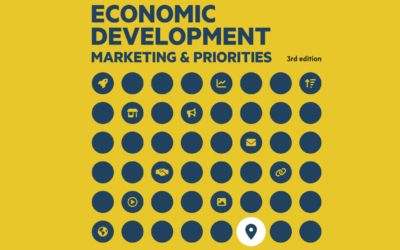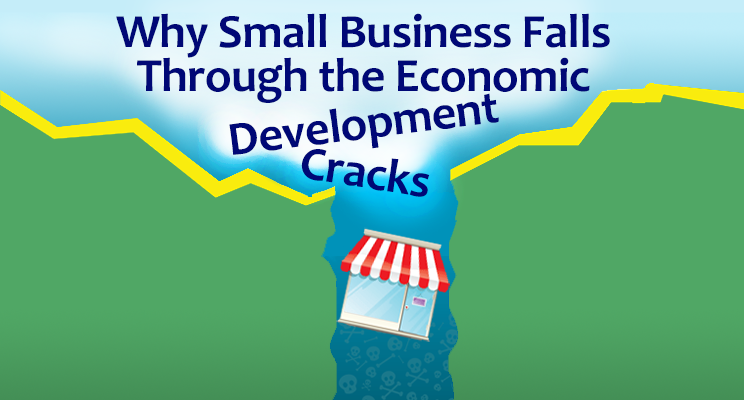
There are two things related to small business that nearly all economic developers believe: 1. Small businesses are the economic engine of local communities, creating the most net new jobs and sustaining the local economy, and 2. Someone else is taking care of helping small businesses. Both beliefs are insightful and show the disconnect between what matters and what gets attention.
Belief #1: Small Businesses Are Essential for Successful Economic Development
Small businesses create 64% of all net new private sector jobs.[1] Moreover, they broke a 45-year record for adding jobs in 2019.[2] If job creation is a priority for your economic development organization (EDO) small businesses are your best and most accessible means of creating jobs. In addition, a successful small business in your community can grow to become a medium and large business, facilitating more economic activity, generating more local taxes, and creating even more jobs.
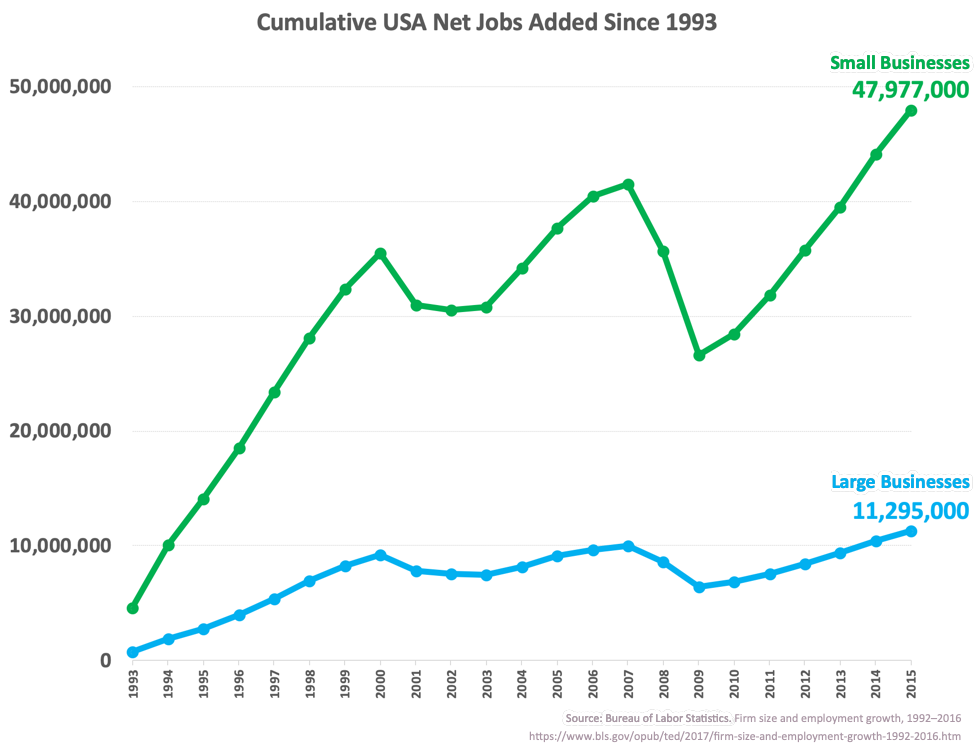
Locally-owned businesses have a greater economic impact on your local economy because more of the revenue that these local, small businesses earn stay within your area.[3] This is because the people running these locally-owned businesses live in the community and therefore spend more locally. In economic terms, the multiplier effect is stronger for local-owned businesses. This is different than businesses headquartered out-of-town that take profits to owners and executives in the company’s headquarter city or, for publicly traded companies, that disburse profits as dividends to shareholders around the world. Those profits leave your community.
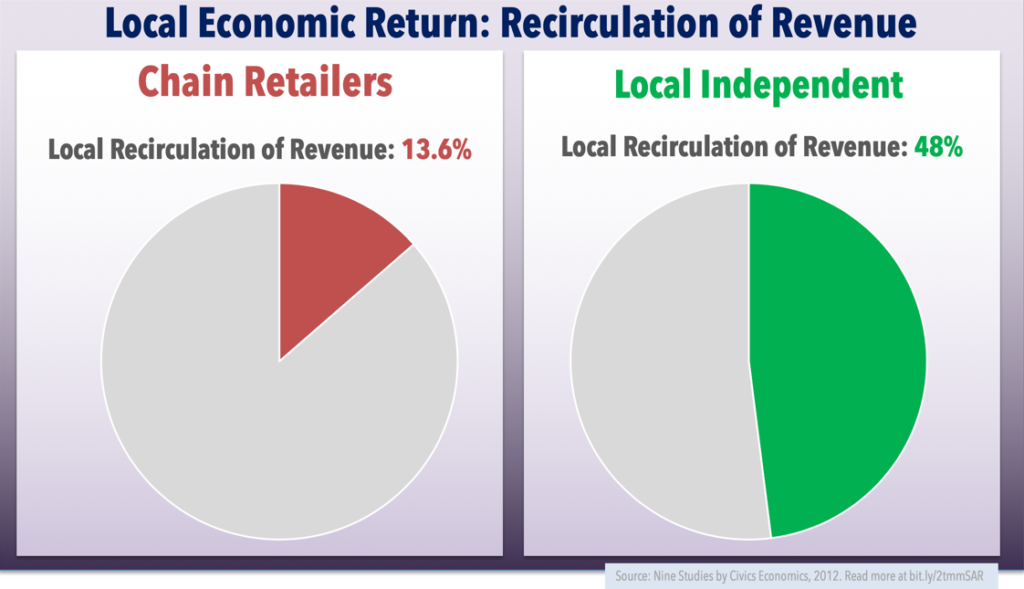
Small businesses are a logical path for achieving success for economic developers that want to achieve job creation and maximize the vitality of the local economy, which is why they should be a top priority.
However, research from the International Economic Development Council’s State of the Industry 2019 confirms that direct small business assistance is not a top priority for economic developers. Instead, 1. business attraction, 2. business retention, and 3. workforce training are the top priorities.[4] A person might think, “but business attraction and workforce training are economic development efforts that help small business.” However, later in this article you’ll see why the actual work economic developers do in these two areas isn’t much direct help to small businesses at all.

Belief #2: Someone Else is Helping Small Business
The insight that many economic development professionals (EDpros) believe that someone else other than their organization is helping small businesses and therefore they don’t need to make small business assistance a priority is an insight that has been learned from my colleagues speaking with thousands of EDpros all across the country. What is even more interesting is that whether it is a city, county, region, or state, the response from EDpros is consistent that they think supporting small businesses is extremely important but that their office/department doesn’t do it and they leave small business assistance to other organizations. A common follow-up response is that they aren’t often sure exactly which organizations are helping small businesses.
The belief that someone else is taking care of this important priority results in few economic developers, if any, in a community actively engaging in direct programs and policies that support small business economic development.
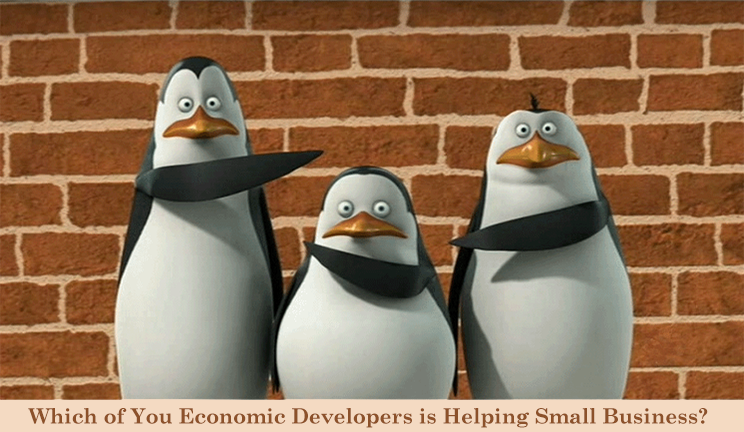
Someone Is Helping Small Businesses, Right?
There are myths and realities about which programs help small businesses. Some are designed to help them while others are not.
Business Retention and Expansion (Myth)
The myth of Business Retention and Expansion (BRE) is that it is a small business economic development program. Although it can be, mostly it is not. Even BRE experts from Executive Pulse recommend a Darwinian “survival of the fittest” model to focus on the most valuable companies and not try to serve all companies in an industry. When the focus is on the most valuable companies, the largest companies in town are the ones that get the BRE assistance because losing or growing them could have the most negative or positive impact due to their size.
A key reason why only the most valuable and largest companies get BRE assistance is, as IEDC explains, “A business retention program is time and labor intensive.” It isn’t possible to scale to serve many businesses because of structural limitations related to staffing and time. There are only so many economic development staff, they often have multiple program responsibilities in addition to BRE, and staff can’t expand to work more hours to reach more businesses, let alone all of the small businesses in the community. It’s not the fault of EDO staff that they can’t serve many small businesses with BRE, because the traditional BRE structure isn’t designed for scale. IEDC addresses this challenge too, suggesting EDOs “should begin by creating a database of existing businesses, and determining the kinds of businesses toward which it will target its efforts.” These targets don’t end up serving many locally-owned, small businesses.
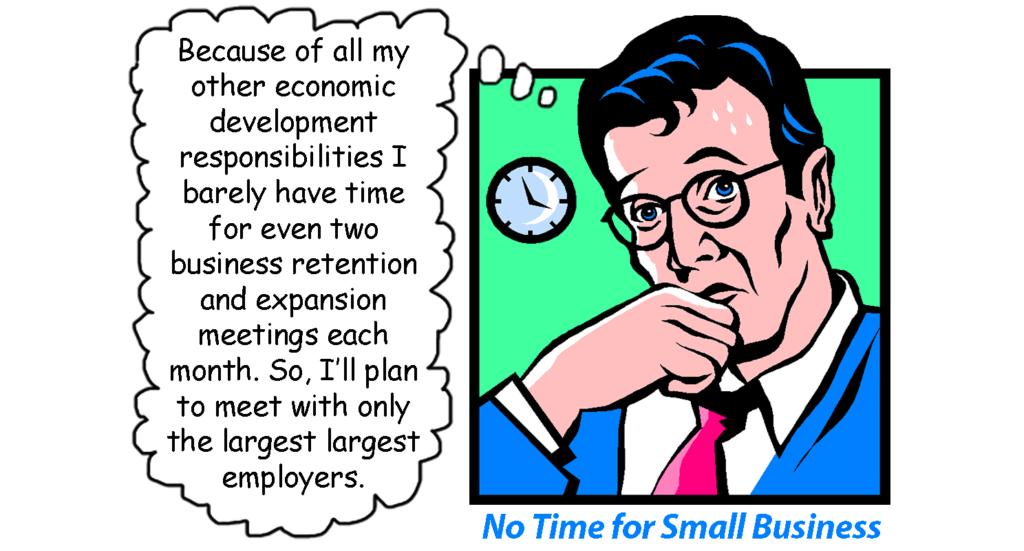
Economic Gardening (Myth and Reality)
The practice of Economic Gardening is agnostic to the size of the business, although it generally does not serve recently started companies. Instead, Economic Gardening staff focus on fast-growing companies referred to as gazelles. The idea is to assist companies that show quantitative indicators that they can grow quickly and therefore deliver a disproportionately larger positive impact on the local economy. Businesses that receive Economic Gardening assistance could be small, medium, or large in size and, because most businesses are small businesses, there is a likelihood that more small businesses will be served.
Economic Gardening is a type of management consulting to local businesses to help them accelerate their growth. It requires EDpros with specialized technical and analytical skills including market research, geographic information systems analysis, online marketing, competitor tracking, and customer identification. These EDpros work one-on-one with businesses as analysts. This type of quality is individually labor intensive which means it is not feasible to scale the program to serve large volumes of small businesses. By definition Economic Gardening is designed to exclude small businesses which are identified as not having the capability to grow quickly, which includes most businesses.
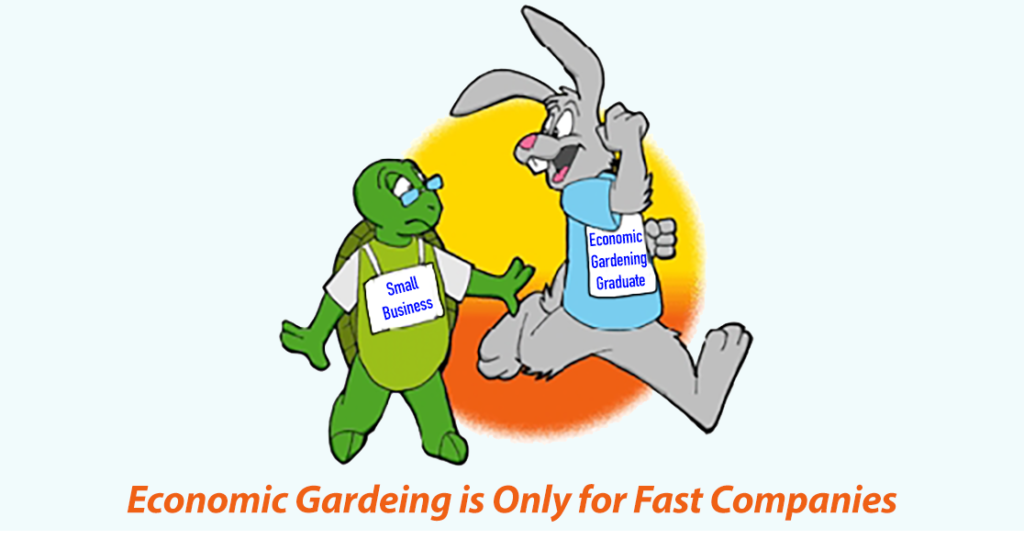
Workforce Training (Reality and Myth)
Access to quality labor with the skills needed by companies has become such an acute challenge that it is at the top of most companies’ pain points. Economic developers are aware of this and are becoming more engaged in strategies to bridge this skills shortage. A new way they are doing this is through talent attraction. But the more traditional and sustainable way that employees are getting skills training is through workforce training. Workforce training programs can help all businesses in an area whether they are small or large. However large companies can more easily influence the development of workforce training specialized for their companies because of their scale, whereas small businesses cannot. This type of customized workforce training also favors companies that are growing and exporting outside of the area,[5] which many locally-serving small businesses may not qualify for.
Workforce training is a much larger profession and which is higher-funded than economic development. The Workforce Innovation and Opportunity Act (WIOA), the largest dedicated source of federal funding for job training, alone spends nearly $3 billion each year[6] and there are many more workforce training programs available at the local, state, and national levels. Although the USA spends much less as a share of its GDP on labor market training compared to industrialized OEDC countries, it is still far more than is spent on economic development budgets. Economic developers can be key partners for and influencers of workforce training programs, few workforce training programs are run and managed by economic development organizations.
Small Business Development Centers, SCORE, Women Business Centers and Veteran Business Outreach Centers (Reality)
The US Small Business Administration oversees the direct delivery of small business services through Women Business Centers (WBC), Veteran Business Outreach Centers (VBOCs), SCORE, and Small Business Development Centers (SBDC). WBCs and VBOCs provide services to targeted demographics of entrepreneurs and small businesses.[7] SBDCs and SCORE focus on the general population of small businesses wanting assistance.[8] Services are provided a variety of ways but primarily focus on “how to” classes, mentoring, workshops, and individualized advisory services, although the types of services vary by organization and location. Services include business planning, accessing capital, marketing, regulatory compliance, technology development, international trade and more.[9]

The Huge Gap of Small Businesses Getting Assistance
Nationwide, there are only 128 Women Business Centers[10] and only 22 Veteran Business Outreach Centers[11]. In many cases only one or zero centers are in each state.
The Association of SBDCs describes that it is “the most comprehensive small business assistance network in America” and that the nearly 1,000 SBDCs in the US and US territories serve over 1 million small business owners and aspiring entrepreneurs each year.[12] As the leader in providing small business services it is laudable that, on average, 1,000 small businesses and entrepreneurs are served annually by each SBDC. However, to put this in perspective, there are 35,856 municipalities and townships in the USA[13] and 30.2 million small businesses.[14] This equates to less than one SBDC for every 35 counties and 3% of all US businesses being served.[15]
The proportions achieved should in no way diminish the important work that these organizations and professionals are doing. They are all incredibly important in the national infrastructure to help small businesses and entrepreneurs. These organizations and the services they provide should be better funded, expanded, and supplemented. What the metrics show is that there is a massive gap in the size of the business population compared to the amount of businesses that are actually served.
One of the key reasons for the inability to assist more small businesses is that the current model of small business assistance is limited by financial and human resources. There are only so many small business assistance professionals to help these companies and financial funding constrains the volume of staff that can be hired and programs that can be implemented.
Many Economic Development Organizations Do Not Directly Provide Small Businesses Services and Small Businesses Assistance Organizations Do Not Serve Most Small Businesses
EDOs may do BRE or Economic Gardening, but they probably do not have programs/services that directly provide small business assistance or workforce training. Yet, if their mission is to create jobs (which is the most common top priority for EDOs) and increase local economic activity, there is no way to accomplish either effectively without focusing directly on small businesses and entrepreneurship.
Even if EDOs leave small business assistance to the national small business assistance organizations, it’s evident that the small businesses in the EDO’s community are likely to be under-served because there aren’t enough SMB assistance organizations, staff, and programs (assuming they are even located in the area at all) to reach the large number of small businesses in the EDO’s community.
It’s no one’s fault, because this a limitation of funding, staffing, and traditional programs. But this problem needs a solution for EDOs to implement their mission, achieve their goals, and grow their local economies.
A New Model for Small Business Assistance
Two of the most glaring weaknesses of existing small business assistance programs are 1. scalability and 2. geography. Only a small amount of small businesses can be served through traditional programs and the services are not necessarily geographically nearby or convenient to access.
A solution to both of these problems is to leverage new technology to provide scalable solutions to serve massive numbers of small businesses and deliver these services through the Internet so they can be accessed in any geography with an Internet connection.
The following are online small business assistance programs that solve these issues of scale and access:
Solution #1: Online Training
Business education and training from top university professors can now be accessed by entrepreneurs for free through the Massive Open Online Courses (MOOC) provided by edX. The global non-profit edX has four key university partners including MIT, Harvard, University of California at Berkeley, and The University of Texas system, along with over 120 other institutional partners. There are currently over 450 available courses for business and management with subject areas including digital strategy, economics, finance, product development, and operations. All courses can be audited for free or can be taken to receive a verified certificate for a fee. As an economic development organization, you can link to these services from your website and promote these professional development opportunities to small businesses and entrepreneurs in your community.https://www.linkedin.com/embeds/publishingEmbed.html?articleId=8150050500840571701
There are also for-profit online business training platforms such as Udemy that provide thousands of courses for small business owners, managers, and entrepreneurs. Udemy has promoted itself as helping “organizations of all kinds prepare for the ever-evolving future of work.” Udemy exists within the MOOC movement outside of traditional universities, it has positioned that “Udemy believes that the world’s best teachers aren’t always found in the classroom” and that their instructors are “experts who stay active in their fields in order to deliver the most up-to-date content”.[16] Because courses on Udemy must be purchased, EDOs could consider allocating small business training budgets to subsidize the costs for local companies wanting to access this customized job training education.[17]
Online educational training like edX and Udemy are scalable to as many small businesses that can watch the online courses and can be accessed anywhere with an Internet connection, which solves the two big barriers that exist in current small business assistance programs.
Solution #2: Online Research
In today’s information economy, businesses without access to information are at a higher risk for stunted growth or failure. Large corporations can afford to hire management consultants and research analysts to use data to gain insights and plan a path for their success. Small businesses are informationally disadvantaged in today’s society because they have not been able to access, afford, or understand business intelligence like large companies. Fortunately for small businesses, now there is a way for EDOs to help level the competitive business playing field by providing their local businesses with easily understandable market research based on big data, algorithm-based analysis, super-computing, and which is delivered through the Internet.
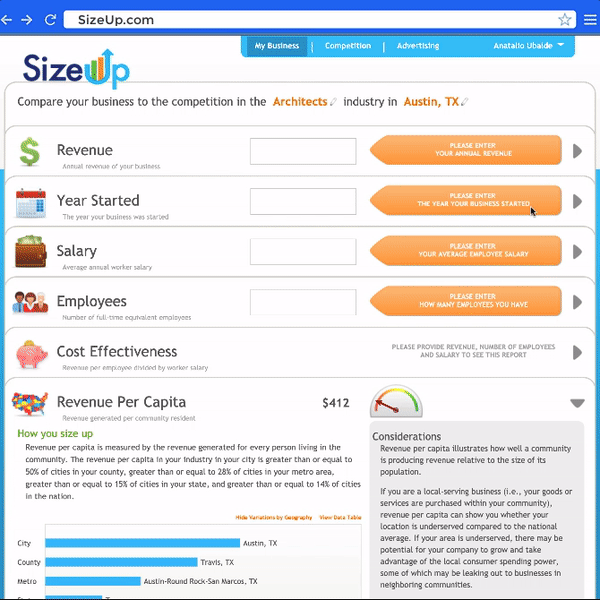
Economic development organizations are placing SizeUp LBI research services on their websites to provide their local companies with customized access to high-quality data and market research that is specific by detailed industries and hyper-local to be relevant. Now small companies can access similar business intelligence used by huge corporations so that they can benchmark and rank their performance against industry competitors; discover potential customers, suppliers, and better understand the competitive landscape; optimize advertising to target ideal customers; and granularly analyze local and regional demographics to uncover market opportunities. The service is free to local small businesses and affordable to EDOs. https://www.linkedin.com/embeds/publishingEmbed.html?articleId=8253979197486362881
Online business research using SizeUp LBI on economic development organizations’ websites is scalable to as many small businesses that want the custom data research and it can be accessed anywhere with an Internet connection, which solves the two big barriers that exist in current small business assistance programs.
Why Economic Development Organizations are Ideal to Empower Small Business
Economic development organizations are well positioned to implement specific types of small businesses assistance programs because of their local presence/relationship with local companies and because the success of small businesses is directly aligned with their goals for economic development.
Unlike small business assistance organizations which are relatively small in number and may be geographically inconvenient, economic development organizations are numerous and are located in municipal, county, and metro organizations across the entire country.
EDOs don’t need to provide all types of small business assistance service, but they can certainly provide complimentary new small business assistance programs which are not currently provided by traditional small business assistance organizations that leverage new technology platforms and can be delivered through the Internet. These innovations in scalable, online, small business assistance services are empowering economic development organizations to provide services which were never possible before, provide direct service to their local businesses, and provide a direction programmatic connection that facilitates their goals of job creation, increased economic multipliers, and maximized economic vitality of the communities they serve.
Now it is up to economic development professionals to not only affirm that small businesses are critical for their success but to also dismiss the antiquated thinking that supporting local businesses with direct assistance is someone else’s job. Small business is at the core of local economic development success and helping small businesses thrive is the responsibility of the local economic developer.
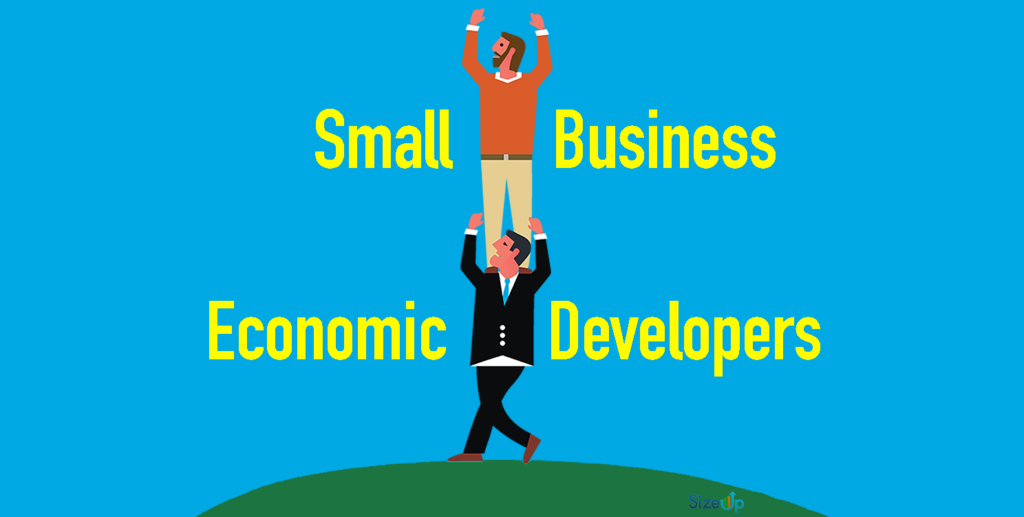
Footnotes:
[1] US Small Business Administration Office of Advocacy 2002 – 2010.
[2] “Small Business Job Creation Breaks 45-year Record,” NFIB press release March 7, 2019. This news release summarizes findings of the NFIB monthly jobs report. According to the research based on February 2019 data, small businesses had net addition of 0.52 workers per firm. The previous record was in May 1998 at 0.51 workers per firm.
[3] Civics Economics research study
[4] International Economic Development Council State of the Industry, January 2019 presented by Jeffrey Finkle at the IEDC Leadership Summit in Fort Lauderdale, Florida.
[5] As examples, North Carolina’s custom workforce training requires that eligible companies meet two of the following requirements: The company is creating jobs, expanding an existing workforce, or enhancing the productivity and profitability of its operations within the state; The company is making an appreciable capital investment; The company is deploying new technology, or; The assistance will enhance the skills of workers. Nebraska’s Customized Job Training prioritizes training projects that: Result in increased investment and employment in Nebraska; Provide a significant incentive for new jobs or investments to be undertaken in Nebraska rather than a different state; and Involve retraining of existing workers to upgrade their skills as a result of investment in new capital. In addition, only Nebraska for-profit businesses who sell products and/or services to markets outside of the state are eligible for Customized Job Training grants.
[6] Although more money is spent nationally on traditional labor force programs than economic development, internationally the United States lags far behind most OEDC industrialized countries in workforce training and programs to assist workers. WIOA funding declined 43% from 2001 to 2017.
[7] Women Business Centers help women succeed in business by providing training, mentoring, business development and financing opportunities to over 140,000 women entrepreneurs each year in every state in the union. Source: Association of Women Business Centers.
[8] SCORE provides business mentors and has helped more than 11 million entrepreneurs through mentoring, workshops and educational resources since its founding in 1964. In 2018, SCORE mentors helped start 32,387 businesses and created 135,687 jobs. Source: https://www.score.org
[9] America’s Small Business Development Centers. https://americassbdc.org
[10] Association of Women’s Business Centers.
[11] Office of Veteran Business Sources.
[12] America’s Small Business Development Center website and 2019 Annual Report
[13] United States Census Bureau newsroom, as of August 30, 2012.
[14] US Small Business Administration Office of Advocacy, 2018 Small Business Profile.
[15] Even fewer small businesses than 3% are likely served because SBDC includes entrepreneurs in their service statistics. These entrepreneurs may not yet have opened businesses.
[16] Udemy About Us webpage. May 2019.
[17] EDOs are already familiar with paying for and providing Customized Job Training programs. Online professional training in which the entrepreneur is choosing custom training courses is also getting Customized Job Training. Framing in this way may make it easier for you to access funding from existing economic development program budgets for online education.



